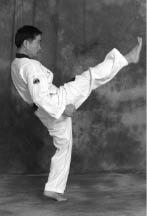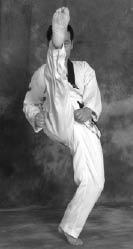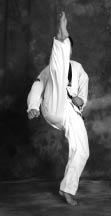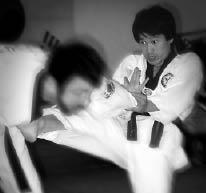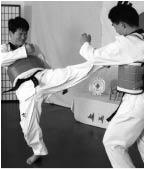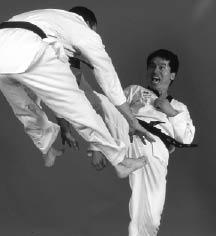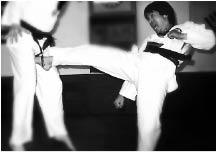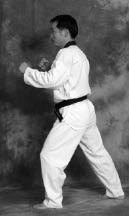Complete Kicking (6 page)
Authors: Turtle Press

3. As your hip snaps forward, extend your knee and kick. Keep your standing knee bent, using the thigh muscles to firmly stabilize your stance. Tuck your chin down, lean your torso slightly backward to add extra reach (length). Exception: If you are moving forward, bring your torso forward instead of leaning back.
4. Withdraw the foot quickly after the kick and repose.
FRONT VIEW (above) of front kick: notice the position of the left hand to protect the groin and the right hand to maintain balance. You can also keep your hands up in a guard position. The head, hip and standing foot are aligned vertically for maximum stability.
applications
Front kick is the most direct and easiest kick to execute, so you can instinctively throw it in almost any situation. For self-defense, it is useful for striking the groin, stomach or solar plexus directly, or in combination with a hold or lock. For sport competition, you can stop an opponent by kicking his lower abdomen or knock him down by kicking his neck vertically with the blade of your foot.
SPORT APPLICATION: Front kick to the neck using the blade of the foot. (Kicking the neck is not allowed in some combat sports.)
SELF-DEFENSE APPLICATION: Front kick to the chest in combination with a twisting wrist lock
SPORT APPLICATION: If an opponent rushes toward you, throw a front kick to push him away. As the opponent backs up, throw another front kick or a roundhouse kick or axe kick.
SELF-DEFENSE APPLICATION: A front kick to the pelvic plexus can knock an opponent down. Push deeply into the pelvis with the ball or bottom of the foot.
SPORT APPLICATION: Blade front kick to the carotid artery in the neck can result in a knock down or knockout. Recommended for advanced students only.
SELF-DEFENSE APPLICATION: For front kick to the groin, use the full instep of the foot to drive upward.
common mistakes
MISTAKE 1: The most serious mistake people make in executing a front kick is tilting the head, which disrupts your balance.
SOLUTION: Tuck your chin down toward your chest.
MISTAKE 2: Arm position: too wide, too narrow or too low.
SOLUTION: To practice keeping your arms close to your body in fighting stance, hold the collars of your uniform and practice.
MISTAKE 3: Excessively raising the heel of the standing foot.
SOLUTION: If you feel that you have to raise up onto the toes of your standing foot, pivot your standing foot slightly more when you kick or lower the height of your kick.
MISTAKE 4: Leaning too far back/away from the target.
SOLUTION: To kick, you should decline your torso slightly but not so much that you lose your balance. If you are leaning back too much, lower the height of your kick until you improve your flexibility or raise your knee higher when you chamber your kicking leg.
• remember
1. Keep your head straight.
2. Tuck your chin down.
3. Position both elbows at equal height.
4. Aim your knee at the target and kick directly to the target.
• avoid
1. Tilting your head
2. Leaning your torso too far backward
3. Opening your arms too wide
4. Dropping your hands
5. Holding your arms too tight in front of your chest
6. Lifting your standing heel excessively
ROUNDHOUSE KICK
purpose
Roundhouse kick is used to strike lateral targets on the trunk, head and legs of an opponent who is facing you. If your opponent stands sideways in front of you, kick the front of his torso. Due to its effectiveness and simplicity, roundhouse kick is the most commonly used kick in competition. It is a versatile weapon for attacking and counterattacking against any type of opponent.
key points
Bend your kicking knee forward acutely, rotate your hip and snap the ball or instep of your foot quickly and powerfully to the target. When attacking, bring your body forward for more power. For counterattacking, turn your body sideways or lean slightly backward to avoid being hit.
striking area
Ball, instep, shin, toes
targets
1. rib cage
2. thigh (inside, outside)
3. knee (inside, outside)
4. ankle (inside, outside)
5. neck
6. head
7. chest
8. solar plexus
9. lower abdomen
how to
1. From fighting stance, shift your weight to the front leg.
Other books
Angel's Pain by Maggie Shayne
Christmas in the Trenches by Alan Wakefield
Teenage Mermaid by Ellen Schreiber
White Bone by Ridley Pearson
Demon Slave by Fay, Kiersten
The Matchmaker by Marita Conlon-McKenna
Trouble & the Wallflower by Kade Boehme
When in Rome by Giusti, Amabile
Deep Secret by Diana Wynne Jones
Skinny Dipping Season by Cynthia Tennent
